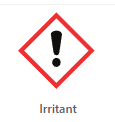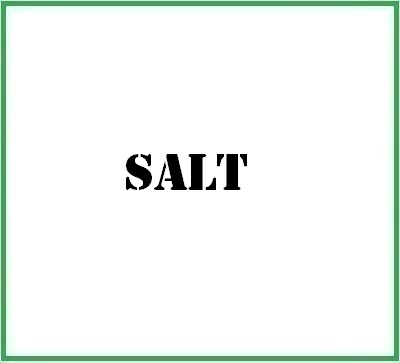![]() Salt
Salt
Rating : 4.7
| Evaluation | N. Experts | Evaluation | N. Experts |
|---|---|---|---|
| 1 | 6 | ||
| 2 | 7 | ||
| 3 | 8 | ||
| 4 | 9 | ||
| 5 | 10 |
Cons:
Possible risk. Click on ingredient (1)7 pts from RS232
| Sign up to vote this object, vote his reviews and to contribute to Tiiips.Evaluate | Where is this found? |
| "Salt studies" about Salt Review Consensus 8 by RS232 (2058 pt) | 2022-Jul-04 10:15 |
| Read the full Tiiip | (Send your comment) |
Salt and hypertension
Morowatisharifabad MA, Salehi-Abargouei A, Mirzaei M, Rahimdel T. Behavioral beliefs of reducing salt intake from the perspective of people at risk of hypertension: An exploratory study. ARYA Atheroscler. 2019 Mar;15(2):59-66. doi: 10.22122/arya.v15i2.1900.
Abstract. This study was a TPB-based exploratory research. The participants were 25 married individuals at risk of developing HTN, with a mean age of 42.9 ± 7.2 years. They were selected by purposive maximum variation sampling continued until data saturation. The data collection method was a semi-structured interview. Study lasted from January 2017 to April 2017.
Grillo A, Salvi L, Coruzzi P, Salvi P, Parati G. Sodium Intake and Hypertension. Nutrients. 2019 Aug 21;11(9):1970. doi: 10.3390/nu11091970.
Abstract. The close relationship between hypertension and dietary sodium intake is widely recognized and supported by several studies. A reduction in dietary sodium not only decreases the blood pressure and the incidence of hypertension, but is also associated with a reduction in morbidity and mortality from cardiovascular diseases. Prolonged modest reduction in salt intake induces a relevant fall in blood pressure in both hypertensive and normotensive individuals, irrespective of sex and ethnic group, with larger falls in systolic blood pressure for larger reductions in dietary salt. The high sodium intake and the increase in blood pressure levels are related to water retention, increase in systemic peripheral resistance, alterations in the endothelial function, changes in the structure and function of large elastic arteries, modification in sympathetic activity, and in the autonomic neuronal modulation of the cardiovascular system. In this review, we have focused on the effects of sodium intake on vascular hemodynamics and their implication in the pathogenesis of hypertension.
D'Elia L, La Fata E, Giaquinto A, Strazzullo P, Galletti F. Effect of dietary salt restriction on central blood pressure: A systematic review and meta-analysis of the intervention studies. J Clin Hypertens (Greenwich). 2020 May;22(5):814-825. doi: 10.1111/jch.13852.
Abstract. Central blood pressure (cBP) is highly associated with cardiovascular risk. Although reduction of salt intake leads to lower peripheral blood pressure (BP), the studies on cBP provided inconsistent results. Therefore, we performed a systematic review and a meta-analysis of the available intervention trials of salt reduction on cBP values to reach definitive conclusions.
Khan MS, Jones DW, Butler J. Salt, No Salt, or Less Salt for Patients With Heart Failure? Am J Med. 2020 Jan;133(1):32-38. doi: 10.1016/j.amjmed.2019.07.034.
Abstract. In this review we discuss the pros and cons of sodium restriction for patients with heart failure from the current literature.
Salt diet
Barone M, Turroni S, Rampelli S, Soverini M, D'Amico F, Biagi E, Brigidi P, Troiani E, Candela M. Gut microbiome response to a modern Paleolithic diet in a Western lifestyle context. PLoS One. 2019 Aug 8;14(8):e0220619. doi: 10.1371/journal.pone.0220619.
Abstract. The modern Paleolithic diet (MPD), featured by the consumption of vegetables, fruit, nuts, seeds, eggs, fish and lean meat, while excluding grains, dairy products, salt and refined sugar, has gained substantial public attention in recent years because of its potential multiple health benefits. However, to date little is known about the actual impact of this dietary pattern on the gut microbiome (GM) and its implications for human health. In the current scenario where Western diets, low in fiber while rich in industrialized and processed foods, are considered one of the leading causes of maladaptive GM changes along human evolution, likely contributing to the increasing incidence of chronic non-communicable diseases, we hypothesize that the MPD could modulate the Western GM towards a more "ancestral" configuration. In an attempt to shed light on this, here we profiled the GM structure of urban Italian subjects adhering to the MPD, and compared data with other urban Italians following a Mediterranean Diet (MD), as well as worldwide traditional hunter-gatherer populations from previous publications. Notwithstanding a strong geography effect on the GM structure, our results show an unexpectedly high degree of biodiversity in MPD subjects, which well approximates that of traditional populations. The GM of MPD individuals also shows some peculiarities, including a high relative abundance of bile-tolerant and fat-loving microorganisms. The consumption of plant-based foods-albeit with the exclusion of grains and pulses-along with the minimization of the intake of processed foods, both hallmarks of the MPD, could therefore contribute to partially rewild the GM but caution should be taken in adhering to this dietary pattern in the long term.
Barić L, Drenjančević I, Matić A, Stupin M, Kolar L, Mihaljević Z, Lenasi H, Šerić V, Stupin A. Seven-Day Salt Loading Impairs Microvascular Endothelium-Dependent Vasodilation without Changes in Blood Pressure, Body Composition and Fluid Status in Healthy Young Humans. Kidney Blood Press Res. 2019;44(4):835-847. doi: 10.1159/000501747.
Abstract. We aimed to assess whether a 7-day high-salt (HS) diet affects endothelium-dependent and/or endothelium-independent microvascular function in the absence of changes in arterial blood pressure (BP), and to determine whether such microvascular changes are associated with changes in body composition and fluid status in healthy young humans.
McCubbin AJ, Lopez MB, Cox GR, Caldwell Odgers JN, Costa RJS. Impact of 3-day high and low dietary sodium intake on sodium status in response to exertional-heat stress: a double-blind randomized control trial. Eur J Appl Physiol. 2019 Sep;119(9):2105-2118. doi: 10.1007/s00421-019-04199-2.
Abstract. To determine the impact of altering dietary sodium intake for 3 days preceding exercise on sweat sodium concentration [Na+], and cardiovascular and thermoregulatory variables.
Cashman KD, Kenny S, Kerry JP, Leenhardt F, Arendt EK. 'Low-Salt' Bread as an Important Component of a Pragmatic Reduced-Salt Diet for Lowering Blood Pressure in Adults with Elevated Blood Pressure. Nutrients. 2019 Jul 26;11(8):1725. doi: 10.3390/nu11081725.
Abstract. Reformulation of bread in terms of salt content remains an important measure to help achieve a reduction in salt intake in the population and for the prevention of hypertension and elevated blood pressure (BP). Our fundamental studies on the reduction of salt on dough and bread characteristics showed that wheat breads produced with 0.3 g salt/100 g ("low-salt") were found to be comparable quality to that produced with the typical level of salt (1.2%). This food-based intervention trial examined, using a 5 week cross-over design, the potential for inclusion of "low-salt" bread as part of a pragmatic reduced-salt diet on BP, markers of bone metabolism, and plasma lipids in 97 adults with slightly to moderately elevated BP. Assuming all sodium from dietary intake was excreted through the urine, the intake of salt decreased by 1.7 g/day, on average, during the reduced-salt dietary period. Systolic BP was significantly lower (by 3.3 mmHg on average; p < 0.0001) during the reduced-salt dietary period compared to the usual-salt dietary period, but there was no significant difference (p = 0.81) in diastolic BP. There were no significant differences (p > 0.12, in all cases) in any of the urinary- or serum-based biochemical indices of calcium or bone metabolism or in plasma lipids between the two periods. In conclusion, a modest reduction in dietary salt intake, in which the use of "low-salt" (i.e., 0.3 g/100g) bread played a key role along with dietary advice, and led to a significant, and clinically meaningful, decrease in systolic, but not diastolic, BP in adults with mildly to moderately elevated BP.
Laverty AA, Kypridemos C, Seferidi P, Vamos EP, Pearson-Stuttard J, Collins B, Capewell S, Mwatsama M, Cairney P, Fleming K, O'Flaherty M, Millett C. Quantifying the impact of the Public Health Responsibility Deal on salt intake, cardiovascular disease and gastric cancer burdens: interrupted time series and microsimulation study. J Epidemiol Community Health. 2019 Sep;73(9):881-887. doi: 10.1136/jech-2018-211749.
Abstract. In 2011, England introduced the Public Health Responsibility Deal (RD), a public-private partnership (PPP) which gave greater freedom to the food industry to set and monitor targets for salt intakes. We estimated the impact of the RD on trends in salt intake and associated changes in cardiovascular disease (CVD) and gastric cancer (GCa) incidence, mortality and economic costs in England from 2011-2025.
| Sign up to vote this object, vote his reviews and to contribute to Tiiips.EvaluateClose | (0 comments) |
| "Descrizione" about Salt Review Consensus 7 by RS232 (2058 pt) | 2023-Feb-09 12:46 |
| Read the full Tiiip | (Send your comment) |
Salt or Sodium Chloride is a metal halide composed of sodium and chloride, an inorganic chloride salt with sodium(1+).
It is a white crystalline solid containing calcium and magnesium chlorides and commercially occurs as a white grainy or fine powder soluble in water.

There are different types of salt:
Classic salt, e.g. table salt.
Sea salt is salt obtained from seawater, collected in tanks and evaporated in the sun.

On land, salt is extracted from mines in the form of rock salt and then processed.
Then there is iodized salt, which is a common sea salt to which iodine or potassium, elements that the human body needs, have been added.
There is also diet salt, with a lower percentage of sodium and then a large amount of salt from the most diverse parts of the gobo, Himalayas, South Africa, China etc.
It is advisable to reduce salt consumption as it can cause damage to the cardiovascular system and increase the values of harmful LDL cholesterol and cause hypertension, obesity and other serious diseases.
In cosmetics, sodium chloride acts as a thickener in shampoos and conditioners containing sodium lauryl sulphate, is a co-factor in the eye irritation experienced with most shampoos, and can also cause dryness and itching of the scalp (1).
In the following link you will find the best studies on salt and its health profile.
Sale ed obesità (italian)
Controllare il consumo del sale (italian)
Typical commercial product characteristics Sodium Chloride
| Appearance | White powder |
| Boiling Point | 1461 ºC |
| Melting Point | 801°C(lit.) |
| Flash Point | 1413°C |
| Density | 2.165 1.199 g/mL at 20 °C |
| Refraction Index | n20/D 1.378 |
| Water Solubility | 360 g/L (20 ºC) |
| Storage | +15C to +30C |
| Potassium Iodate | 35±15(20-50) mg/kg |
| Potassium ferrocyanide | ≤10.0 |
| Pb | ≤1.0 |
| As | ≤0.5 |
| F | ≤5.0 |
| Fe | ≤0.0002 |
| Ferrous cyanide | ≤0.0001 |
| Ba | ≤15 |
| Nitrogen | ≤0.001 |
| Sulfate | ≤0.002 |
| Nitrite | 0 |
| Safety |  |
 | |
 |  |
- Molecular Formula NaCl ClNa
- Molecular Weight 58.44
- Exact Mass 57.958622
- CAS 7647-14-5
- UNII 451W47IQ8X
- EC Number 231-598-3
- DSSTox Substance ID DTXSID3021271 DTXSID6040379 DTXSID501033754
- IUPAC sodium;chloride
- InChI=1S/ClH.Na/h1H;/q;+1/p-1
- InChl Key FAPWRFPIFSIZLT-UHFFFAOYSA-M
- SMILES [Na+].[Cl-]
- MDL number MFCD00003477
- PubChem Substance ID 329824637
- ChEBI 26710
- RXCUI 9863
- NSC 77364
- RTECS VZ4725000
- NCI C29974 C821
- Beilstein 3534976
- NACRES NA.21
Synonyms
- Sodium chloride
- Salt
References__________________________________________________________
(1) Staszak K, Wieczorek D, Michocka K. Effect of Sodium Chloride on the Surface and Wetting Properties of Aqueous Solutions of Cocamidopropyl Betaine. J Surfactants Deterg. 2015;18(2):321-328. doi: 10.1007/s11743-014-1644-8.
| Sign up to vote this object, vote his reviews and to contribute to Tiiips.EvaluateClose | (0 comments) |
Read other Tiiips about this object in __Italiano (4)
Content: Last update: 2022-11-16 10:33:47 | Kcal: Family: Threat factors: |


